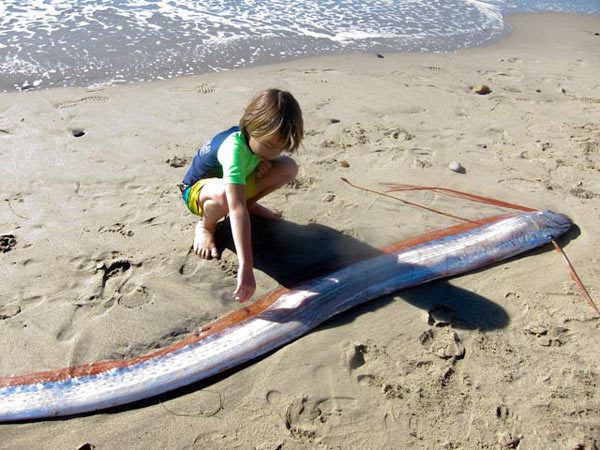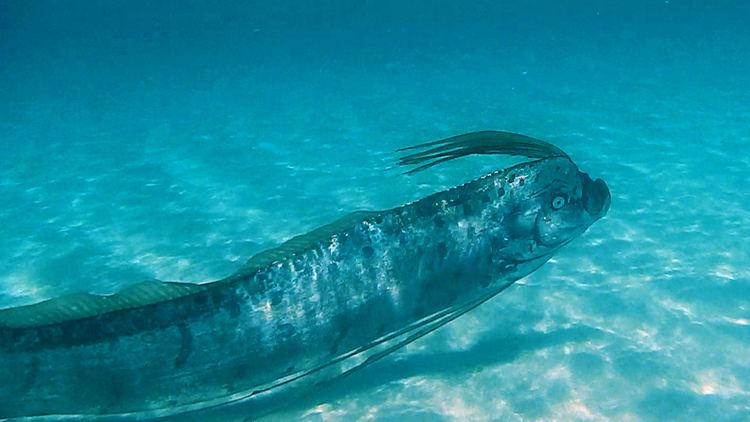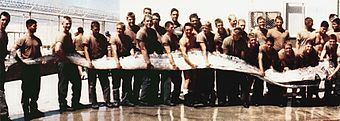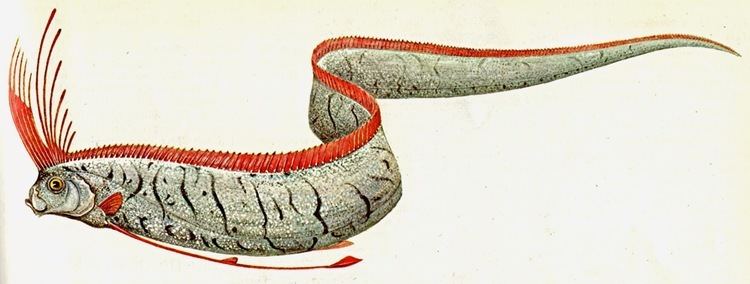Subphylum Vertebrata Scientific name Regalecidae Rank Family | Phylum Chordata Higher classification Lampriformes | |
 | ||
Lower classifications Giant oarfish, Regalecus russelii | ||
Giant oarfish filmed in mexico
Oarfish are large, greatly elongated, pelagic lampriform fish belonging to the small family Regalecidae. Found in all temperate to tropical oceans yet rarely seen, the oarfish family contains four species in two genera. One of these, the giant oarfish (Regalecus glesne), is the longest bony fish alive, growing to up to 11 m (36 ft) in length. That is not enough to qualify as the longest fish, however, as some of the cartilaginous fish such as the basking shark and whale shark are even longer.
Contents
- Giant oarfish filmed in mexico
- Giant oarfish video of 18 ft sea serpent unidentified creature or monster oarfish in california
- Anatomy and morphology
- Range
- Distribution
- Ecology and life history
- Behaviour
- Feeding ecology
- Life history
- References

The common name oarfish is thought to be in reference either to their highly compressed and elongated bodies, or to the now discredited belief that the fish "row" themselves through the water with their pelvic fins. The family name Regalecidae is derived from the Latin regalis, meaning "royal". The occasional beachings of oarfish after storms, and their habit of lingering at the surface when sick or dying, make oarfish a probable source of many sea serpent tales.
Although the larger species are considered game fish and are fished commercially to a minor extent, oarfish are rarely caught alive; their flesh is not well regarded for eating due to its gelatinous consistency.

Giant oarfish video of 18 ft sea serpent unidentified creature or monster oarfish in california
Anatomy and morphology

The dorsal fin originates from above the (relatively large) eyes and runs the entire length of the fish. Of the approximately 400 dorsal fin rays, the first 10 to 13 are elongated to varying degrees, forming a trailing crest embellished with reddish spots and flaps of skin at the ray tips. The pelvic fins are similarly elongated and adorned, reduced to one to five rays each. The pectoral fins are greatly reduced and situated low on the body. The anal fin is completely absent and the caudal fin may be reduced or absent, as well, with the body tapering to a fine point. All fins lack true spines. At least one account, from researchers in New Zealand, described the oarfish as giving off "electric shocks" when touched.

Like other members of its order, the oarfish has a small yet highly protrusible oblique mouth with no visible teeth. The body is scaleless and the skin is covered with easily abraded, silvery guanine. In the streamer fish (Agrostichthys parkeri), the skin is clad with hard tubercles. All species lack gas bladders and the number of gill rakers is variable.

Oarfish coloration is also variable; the flanks are commonly covered with irregular bluish to blackish streaks, black dots, and squiggles. These markings quickly fade following death.
The giant oarfish is by far the largest member of the family at a published total length of 11 m (36 ft)—with unconfirmed reports of 17 m (56 ft) specimens—and 270 kg (600 lb) in weight. The streamer fish is known to reach 3 m (10 ft) in length, while the largest recorded specimen of Regalecus russelii measured 5.4 m (18 ft).
Oarfish have the longest known length of any living species of bony fish.
Range
The oarfish is thought to inhabit the epipelagic to mesopelagic ocean layers, ranging from 1,000 meters (3,300 ft) and is rarely seen on the surface. A few have been found still barely alive, but usually if one floats to the surface, it dies. At the depths the oarfish live, there are little or no currents and so they build little muscle mass and they cannot survive in shallower turbulent water.
Distribution
The members of the family are known to have a worldwide range. However, human encounters with live oarfish are rare, and distribution information is collated from records of oarfish caught or washed ashore.
Ecology and life history
Rare encounters with divers and accidental catches have supplied what little is known of oarfish behaviour and ecology. Apparently solitary animals, oarfish may frequent significant depths up to 1,000 m (3,300 ft). An oarfish measuring 3.3 m (11 ft) and 63.5 kg (140 lb) was reported to have been caught on 17 February 2003 by Ms Val Fletcher using a fishing rod baited with squid, at Skinningrove, United Kingdom.
A photograph on display in bars, restaurants, guesthouses and markets around Laos and Thailand captioned "Queen of Nāgas was seized by the American Army at Mekhong River, Laos Military Base, on June 27, 1973, with the length of 7.80 metres" is, as far as the caption goes, a hoax. The photograph was taken by Dr. Leo Smith of the Field Museum, of an oarfish found in September 1996 by United States Navy SEAL trainees on the coast of Coronado, California, USA.
Behaviour
In 2001, an oarfish was filmed alive in situ: the 1.5-metre (4.9-foot) fish was spotted by a group of U.S. Navy personnel during the inspection of a buoy in the Bahamas. The oarfish was observed to propel itself by an amiiform mode of swimming; that is, rhythmically undulating the dorsal fin while keeping the body itself straight. Perhaps indicating a feeding posture, oarfish have been observed swimming in a vertical orientation, with their long axis perpendicular to the ocean surface. In this posture, the downstreaming light would silhouette the oarfishes' prey, making them easier to spot.
In July 2008, scientists captured footage of the rare fish swimming in its natural habitat in the mesopelagic zone in the Gulf of Mexico. It is the first ever confirmed sighting of an oarfish at depth, as most specimens are discovered dying at the sea surface or washed ashore. The fish was estimated to be between 5 and 10 m (16 and 33 ft) in length.
As part of the SERPENT Project, five observations of apparently healthy oarfish Regalecus glesne by remotely operated vehicles were reported from the northern Gulf of Mexico between 2008 and 2011 at depths within the epipelagic and mesopelagic zones. These observations include the deepest verified record of R. glesne (463–492 m (1,519–1,614 ft)).
From December 2009 to March 2010, unusual numbers of the slender oarfish Regalecus russelii (竜宮の使い “Ryūgū-No-Tsukai”,) known in Japanese folklore as the Messenger from the Sea God's Palace, appeared in the waters and on the beaches of Japan, the appearance of which is said to portend earthquakes.
Scientists claim that oarfish can be the cause for "Nessie Sightings", because when they are sick or dying, they float near the surface of the water.
Feeding ecology
Oarfish feed primarily on zooplankton, selectively straining tiny euphausiids, shrimp, and other crustaceans from the water. Small fish, jellyfish, and squid are also taken. Large open-ocean carnivores are all likely predators of oarfish.
Life history
The oceanodromous Regalecus glesne is recorded as spawning off Mexico from July to December; all species are presumed to not guard their eggs, and release brightly coloured, buoyant eggs, up to 6 mm (0.24 in) across, which are incorporated into the zooplankton. The eggs hatch after about three weeks into highly active larvae that feed on other zooplankton. The larvae have little resemblance to the adults, with long dorsal and pelvic fins and extensible mouths. Larvae and juveniles have been observed drifting just below the surface. In contrast, adult oarfish are rarely seen at the surface when not sick or injured.
